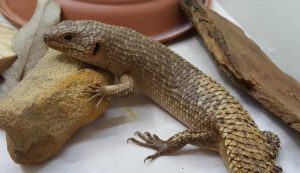This blog post was written by Birgit Szabo. Birgit did her PhD in the Lizard Lab, working on cognition in lizards, with a focus on behavioural flexibility. She is currently a postdoctoral researcher at the University of Bern in Switzerland, working in Dr. Eva Ringler‘s research group. This article first appeared on Birgit’s web page.
Quantities are all around us. From the day we are born we experience the world of numbers even though we might not realise it. At some point in our life we might want a second of our favourite cookie or a bigger scoop of ice-cream thus gaining experience with different quantities.
Animals, like humans, experience quantities naturally during their life. They encounter different sized foods, different numbers of predators and live alone or in family groups and by doing so shape their numerical cognitive abilities. These experiences are unique to each species and likely also to each individual. A basic ability to discriminate between different quantities, to know what is more or larger, should, however, be present across the animal kingdom.
Researchers are very interested in understanding the quantitative abilities of animals because by doing so, we can better understand our own mathematical abilities.

Picture: Gidgee skink (Egernia stokesii) in its’ enclosure at Macquarie University, Sydney, Australia. These lizards are among the most social lizards. They live in multi-generational big family groups composed of a pair and their offspring from multiple years. Even adult offspring are found in these family groups.
A new study in lizards has revealed interesting new insights into the numerical abilities of reptiles. Only two species of reptiles, one tortoise and one lizard, had previously been tested. Lizards showed superior abilities when discriminating food quantities differing in size over number while the tortoises were good at both discriminations. The new study looked at the abilities of the gidgee skink (Egernia stokesii) an Australian lizard species that lives in long-term stable family groups; a rarity among lizards. To the surprise of the research team, these lizards performed better when discriminating quantities differing in number over size.
Both reptiles previously tested are much less social compared to the gidgee skink and the researchers believe that living in a social group might have led to these lizards being better at discriminating between different numbers of food items. It seems like experience with quantities relating to group size might have improved these lizards quantitative ability when it comes to distinct items. There is, however, still much to be learnt about reptile quantitative abilities and about those of the gidgee skink and further research needs to be conducted to confirm that sociality is the selecting force for the gidgee skinks numerical cognitive ability.
The experiences made during the life time strongly affect the brain and cognitive abilities. There is still much to be learned so we can better understand the animals we share our planet with and better understand ourselves.
Here is a link to the paper.
Birgit Szabo, Daniel W A Noble, Kaitlin J McCloghry, Marco E S Monteiro, Martin J Whiting, Spontaneous quantity discrimination in a family-living lizard, Behavioral Ecology, 2021, arab019, https://doi.org/10.1093/beheco/arab019.
